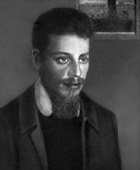Writer and poet, Rilke was considered one of the greatest lyric poets of modern Germany. He created the "object poem" as an attempt to describe with utmost clarity physical objects, the "silence of their concentrated reality." He became famous with such works as Duineser Elegien and Die Sonette an Orpheus . They both appeared in 1923. After these books, Rilke had published his major works, believing that he had done his best as a writer.
Rainer Maria Rilke was born in Prague as the son of Josef Rilke, a railway official and the former Sophie Entz. A crucial fact in Rilke's life was that his mother called him Sophia. She forced him to wear girl's clothes until he was aged five - thus compensating for the earlier loss of a baby daughter. Rilke's parents separated when he was nine. His militarily inclined Father sent him at ten yesrs old to the military academies of St. Pölten and Mahrisch-Weisskirchenn. At the military academy Rilke did not enjoy his stay, and was sent to a business school in Linz. He also worked in his uncle's law firm. Rilke continued his studies at the universities of Prague, Munich, and Berlin.
As a poet Rilke made his debut at the age of nineteen with Leben und Lieder (1894), written in the conventional style of Heinrich Heine. In Munich he met the Russian intellectual Lou Andreas-Salome, an older woman, who influenced him deeply. In Florence, where he spent some months in 1898, Rilke wrote: "... I felt at first so confused that I could scarcely separate my impressions, and thought I was drowning in the breaking waves of some foreign splendor."
With Lou Andreas-Salome and her husband Rilke travelled in Russia in 1899, visiting among others Leo Tolstoy . Rilke was deeply impressed by what he learned of Russian mysticism. During this period he started to write The Book of Hours: The Book of Monastic Life , which appeared in 1905. He spent some time in Italy, Sweden, and Denmark, and joined an artists' colony at Worpswede in 1903. In his letters to a young would-be poet, which he wrote from 1903 to 1908, Rilke explained, that "nobody can counsel and help you, nobody. There is only one single way. Go into yourself. Search for the reason that bids you to write; find out whether you would have to die if it were denied you to write." (in Letters to a Young Poet, 1929 )
In 1901 Rilke married the young sculptress, Klara Westhoff, one of Auguste Rodin's pupils. They had a daughter, Ruth, but marriage lasted only one year. During this period Rilke composed in rhymed, metered verse, the second part of The Book of Hours . The work expressed his spiritual yearning. After Rilke had separated from Klara, he settled in Paris to write a book about Rodin and to work for his secretary (1905-06).
In the Spring of 1906 the overworked poet left Rodin abruptly. Rilke revised Das Buch der Bilder and published it in an enlarged edition. He also wrote The Tale of the Love and Death of Cornet Christopher Rilke , which became a great popular success. During his Paris years Rilke developed a new style of lyrical poetry. After Neue Gedighte (1907-08, New Poems) he wrote a notebook named Die Aufzechnungen des Malte Laurdis Brigge (1910), his most important prose work. It took the form of a series of semiautobiographical spiritual confessions but written by a Danish expatriate in Paris.
Rilke kept silent as a poet for twelve years before writing Duino Elegies and Sonnets to Orpheus , which are concerned with "the identity of terror and bliss" and "the oneness of life and death". Duino Elegies was born in two bursts of inspiration separated by ten years. According to a story, Rilke heard in the wind the first lines of his elegies when he was walking on the rocks above the sea - "Who, if I cried out, would hear me among the angels' hierarchies?"
Rilke visited his friend Princess Marie von Thurnun Taxis in 1910 at Duino, her remote castle on the coast of the Adriatic, and returned again next year. There he started to compose the poems, but the work did proceed easily. After serving in the army, Rilke was afraid that he would never be able to finish it but finally in 1922 he completed Duineser Elegien (Duino Elegies) in a chateau in Muzot, Switzerland. He also wrote an addition, the Sonnets to Orpheus , which was a memorial for the young daughter of a friend. In the philosophical poems Rilke meditated on time and eternity, life and death, art versus ordinary things. The tone was melancholic. Rilke believed in the coexistence of the material and spiritual realms, but human beings were for him only spectators of life, grasping its beauties momentarily only to lose them again. With the power of creativity an artist can try to build a bridge between two worlds, although the task is almost too great for a man. The work influenced deeply such poets as Sidney Keyes, Stephen Spender, Robert Bly, W.S. Merwin, John Ashbery, and W.H. Auden, who had Rilkean angels appear in the collection In Times of War (1939).
In 1913 Rilke returned to Paris, but he was forced to return to Germany because of the First World War. Duino Castle was bombarded to ruins and Rilke's personal property was confiscated in France. He served in the Austrian army and found another patron, Werner Reinhart, who owned the Castle Muzot at Valais. After 1919 he lived in Switzerland, occupied by his work and roses in his little garden. For time to time he went to Paris for a few months or to Italy. Rilke's companion during his last years was the artist Baladine (Elisabeth Dorothea Spiro), whose son, Balthus (Balthasar Klossowski), become also an artist. Rilke wrote a foreword to a book illustrated by Balthus's drawings of cats. Rilke died on December 29, in 1926. |






